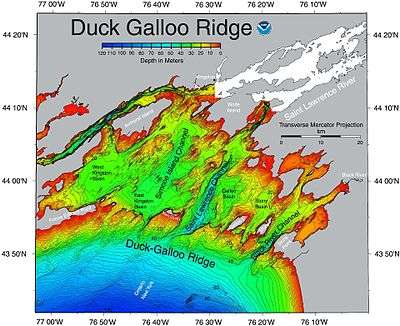Duck Galloo Ridge
The Duck Galloo Ridge is a mainly underwater ridge, at the eastern end of Lake Ontario, spanning from Prince Edward County, Ontario to Jefferson County, New York.[1] In pre-Columbian times native people used the islands on the ridge as way stations, when crossing the lake. The islands and shoals that dot the ridge have been navigational hazards since sailing ships first started navigating the lake.

The Duck Galloo Ridge demarcates a portion of Lake Ontario that is much less deep than most of the rest of the lake.
Islands on the ridge
| image | island | area | first lighthouse | notes |
|---|---|---|---|---|
| Gull Bar | n.a.[2] | |||
| Swetman | 1829 | |||
| Yorkshire | ||||
| Timber Island | ||||
| Main Duck | 570 acres (230 hectares) | |||
| Galloo | 2,210 acres (890 hectares) | |||
| Little Galloo | 44 acres (18 hectares) |
gollark: I never said I was overclocking my GPU.
gollark: *CPU melts*
gollark: *overclocks to 10GHz*
gollark: Actually mine is on constantly.
gollark: Or at least I think I have. You have defeated me with philosophy.
See also
- Scotch Bonnet Ridge
- Salmon Point Ridge
- Point Petre Ridge
References
-
Marc Seguin (2015). "For Want of a Lighthouse: Building the Lighthouses of Eastern Lake Ontario 1828–1914". Trafford Publishing. ISBN 9781490756714. Retrieved 2017-06-22.
This feature is known as the Duck Galloo Ridge. Parts of the ridge rise up abruptly from the lakebed to form rocky underwater shoals; other portions rise up further to form barely submerged reefs; and at a few spots the ridge is exposed above the lake's surface to form low rocky islands.
- Shoals have no meaningful area above water.
This article is issued from Wikipedia. The text is licensed under Creative Commons - Attribution - Sharealike. Additional terms may apply for the media files.